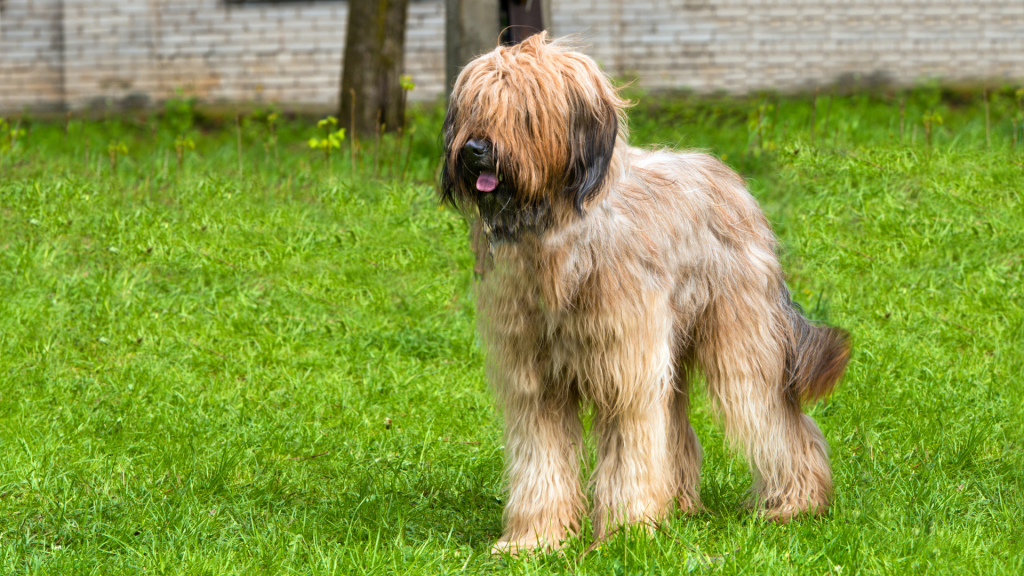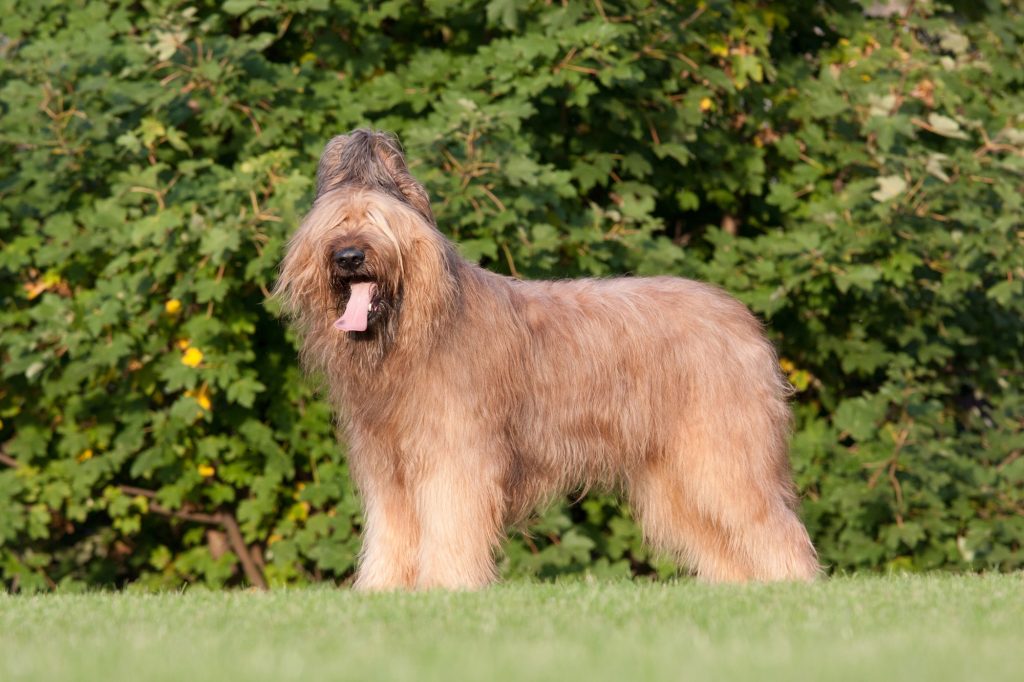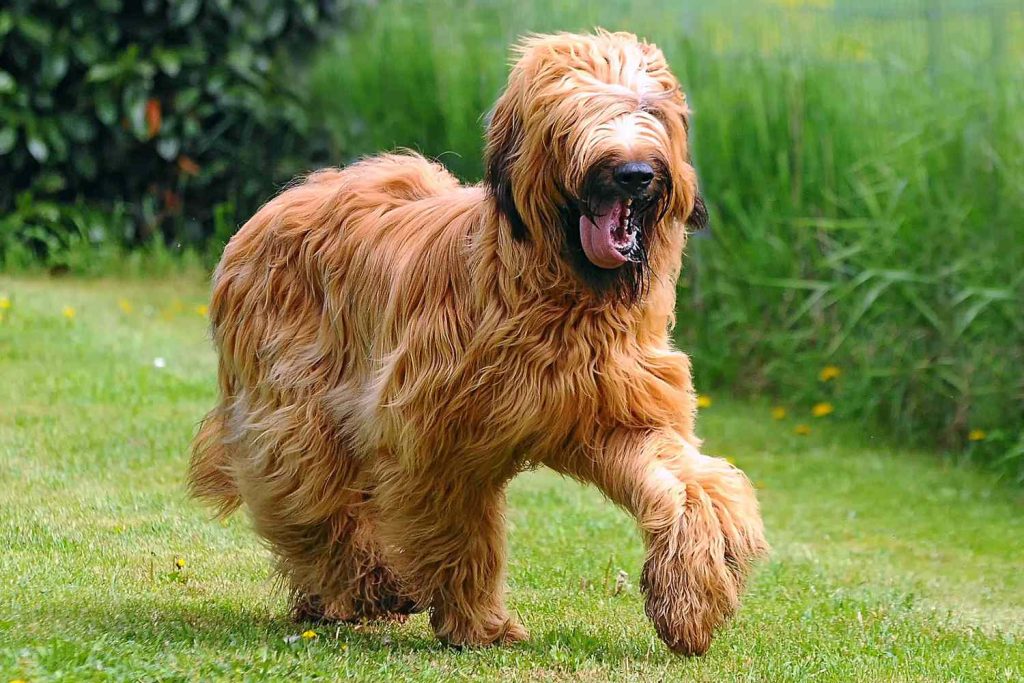Are you thinking about adding a Briard to your family? These furry and loyal dogs have been bred for centuries to be herding and guarding dogs, making them excellent family pets for those who have the time and energy to devote to their care. With their distinctive long, shaggy coat and gentle temperament, Briards are beloved by many dog owners. However, before making the decision to bring one home, it’s important to learn more about the breed’s traits, needs, and temperament to ensure they are a good fit for your lifestyle and family.
Breed Category: Herding
Country of Origin: France
Average Size:60-69 cm (at the shoulder)
Average Weight:30-40 kg
Average Life Span: 10-12 years
Grooming Requirements: High (requires regular brushing and grooming)
Exercise Requirements:High (requires daily exercise and mental stimulation)
History and Origin
The Briard is a large breed of dog that originated in France. The breed is known for its long, shaggy coat and its loyalty to its owners. The history of the Briard can be traced back to the 8th century, where it was used as a herding dog.
During the French Revolution, the Briard was used as a messenger and guard dog. The breed was also used by the French army during World War I and II as a messenger and search and rescue dog. The Briard’s intelligence and loyalty made it an ideal breed for these tasks.
The Briard was first introduced to the United Kingdom in the early 1900s. The breed quickly gained popularity among dog enthusiasts and was recognized by the Kennel Club in 1949. Today, the Briard is still a popular breed in the UK and is often used as a family pet and show dog.
The Briard’s long, shaggy coat requires regular grooming to prevent matting and tangling. The breed’s coat can be black, gray, or tawny in color. The Briard is a large breed, standing up to 27 inches tall at the shoulder and weighing up to 100 pounds.
The Briard is known for its loyalty and protective nature. The breed is often used as a guard dog and is fiercely protective of its family. The Briard is also an intelligent breed and is easily trained. The breed is often used in obedience competitions and agility trials.
In conclusion, the Briard is a breed with a rich history and a loyal and protective nature. The breed’s intelligence and trainability make it an ideal pet for families and a popular choice for dog enthusiasts. The Briard’s long, shaggy coat requires regular grooming, but the breed’s loyalty and protective nature make it a beloved companion for many.

Size and Breed Category
The Briard is a large breed of dog that falls under the category of herding dogs. They are known for their long, shaggy coats that come in a variety of colors such as black, gray, and tawny. The average height of a Briard is around 62-68 cm, and they can weigh anywhere between 30-40 kg. They have a muscular build and a strong, sturdy frame that allows them to perform their herding duties with ease.
Briards are intelligent and loyal dogs that have been used for centuries as herding and guard dogs. They are known for their independent nature and can be quite stubborn at times. However, with proper training and socialization, they can make excellent family pets. They are also highly adaptable and can thrive in both urban and rural environments. Due to their size and energy levels, they require regular exercise and mental stimulation to keep them happy and healthy.
Fur Length and Colour
The fur of this breed is long and thick, with a slightly wavy texture. The hair on the head and ears is shorter and finer, while the hair on the body and legs is longer and coarser. The fur is typically black, gray, or tawny in color, with variations in shade and pattern. Some Briards may have white markings on their chest or feet, but these are not common. The fur requires regular grooming to prevent matting and tangling, and to maintain its healthy shine.
The Briard’s fur is an important characteristic of the breed, providing protection from the elements and helping them blend into their surroundings when working as a herding or guard dog. The fur also gives the Briard a distinctive appearance, with its shaggy, unkempt look and regal bearing. The color and length of the fur can vary depending on the individual dog and its lineage, but all Briards share the same basic characteristics of a thick, wavy coat that requires regular care and attention. Overall, the fur is an essential part of what makes the Briard such a unique and beloved breed.
Termperament and Trainability
Briards are known for their lively and energetic temperament. They are highly intelligent and have a strong desire to please their owners. Briards are also very loyal and protective of their families, making them excellent guard dogs. However, they can be stubborn at times and require consistent training and socialization from an early age. Briards are also known for their playful nature and love to engage in activities such as fetching and playing with toys. Overall, Briards make great companions for active families who are willing to provide them with the exercise and mental stimulation they need.
When it comes to trainability, Briards are generally quick learners and respond well to positive reinforcement training methods. They are highly trainable and excel in obedience and agility competitions. However, Briards can be independent thinkers and may require a firm and consistent hand during training. It is important to establish yourself as the pack leader early on to prevent any potential behavioral issues. Briards also have a strong herding instinct and may try to herd other animals or children, so it is important to socialize them with other pets and children from a young age. With proper training and socialization, Briards can make excellent family pets and working dogs.

Known Health Conditions
Briards are a breed of dog that are known to be prone to certain health conditions. One of the most common health issues that Briards face is hip dysplasia. This is a condition where the hip joint does not develop properly, leading to pain and discomfort for the dog. Briards are also at risk of developing bloat, which is a life-threatening condition where the stomach fills with gas and twists on itself. This can cause a range of symptoms, including vomiting, lethargy, and difficulty breathing. Other health conditions that Briards may be prone to include eye problems, such as cataracts and progressive retinal atrophy, as well as skin allergies and ear infections.
In addition to the health conditions mentioned above, Briards are also at risk of developing certain types of cancer. One of the most common types of cancer in Briards is lymphoma, which is a cancer of the lymphatic system. This can cause a range of symptoms, including swollen lymph nodes, weight loss, and lethargy. Briards may also be at risk of developing osteosarcoma, which is a type of bone cancer that can be very aggressive. Other health issues that Briards may face include hypothyroidism, which is a condition where the thyroid gland does not produce enough hormones, and heart problems, such as dilated cardiomyopathy. It is important for Briard owners to be aware of these potential health issues and to work closely with their veterinarian to ensure that their dog receives the best possible care.

Openness to Strangers
Briards have a reputation for being friendly and welcoming to strangers. They are known to be sociable dogs who enjoy meeting new people and making new friends. Briards are often described as being outgoing and approachable, and they are generally very easy to get along with. They are also known for being loyal and protective of their owners, which can make them excellent guard dogs. Overall, Briards are a breed that is well-suited to living in a variety of different environments, and they are often a popular choice for families who are looking for a friendly and sociable pet.
One of the reasons why Briards are so open to strangers is that they are naturally curious and inquisitive animals. They are always eager to explore new surroundings and meet new people, and they are not easily intimidated by unfamiliar situations. Briards are also very intelligent dogs, and they are quick to learn new things and adapt to new environments. This makes them well-suited to living in a variety of different settings, from busy city apartments to quiet rural homes. Whether you are looking for a loyal companion or a reliable guard dog, a Briard is a breed that is sure to impress.
Playfulness Level
The Briard is a highly playful breed of dog that loves to engage in various activities. They are known for their energetic and lively nature, which makes them an excellent companion for families with children. Briards are always up for a game of fetch or a run in the park, and they thrive on physical activity. They are also highly intelligent and enjoy mental stimulation, so games that challenge their problem-solving skills are a great way to keep them entertained. Overall, the Briard’s playfulness level is high, and they are always eager to have fun with their owners.
In addition to their love for physical activity, Briards also have a playful and mischievous side. They are known for their sense of humor and enjoy making their owners laugh. Briards are also highly social and love to interact with other dogs and people. They are not shy about showing affection and will often seek out attention from their owners. However, their playful nature can sometimes lead to mischief, and they may get into trouble if left unsupervised. Therefore, it is important to provide them with plenty of toys and activities to keep them occupied. Overall, the Briard’s playful nature makes them a fun and entertaining addition to any household.
Suitability as a Pet for Children
Briards have a friendly and loyal nature, making them great companions for children. They are also highly intelligent and trainable, which means they can be taught to behave well around kids. Briards are energetic dogs that require regular exercise, so they are perfect for active families who enjoy spending time outdoors. They have a thick coat that requires regular grooming, but this can be a fun activity for children to participate in. Overall, Briards can make wonderful pets for families with children who are willing to put in the time and effort to properly care for them.
Exercise Needs
Briards require a significant amount of exercise to maintain their physical and mental health. As a medium to large breed, they need at least 60 minutes of daily exercise, which can be achieved through a combination of walks, runs, and playtime. Briards are highly energetic and enjoy activities such as hiking, swimming, and playing fetch. It is important to note that Briards have a strong herding instinct and may try to herd other animals or people during exercise, so it is essential to keep them on a leash or in a secure area. Additionally, Briards thrive on mental stimulation, so incorporating training and interactive games into their exercise routine can help keep them engaged and happy.
In addition to physical exercise, Briards also require mental stimulation to prevent boredom and destructive behavior. They are highly intelligent and enjoy learning new tasks and tricks. Training sessions can be incorporated into their daily exercise routine to provide mental stimulation and improve their obedience. Briards also benefit from interactive toys and puzzles that challenge their problem-solving skills. It is important to note that Briards are sensitive dogs and respond best to positive reinforcement training methods. Harsh or punitive training techniques can cause them to become fearful or aggressive. Overall, providing Briards with a combination of physical and mental exercise is essential for their well-being and happiness.

Suitability for a Multi-Pet Family
Briards have a reputation for being good with other pets in the household. They are known to be gentle and patient with smaller animals such as cats and rabbits. However, as with any breed, it is important to socialize them properly from a young age to ensure they are comfortable around other animals. Briards may also have a tendency to be protective of their family and may need to be introduced to new pets slowly and carefully.

Housing Requirements
Briards require a living space that is large enough to accommodate their active and energetic nature. They need a home with a spacious yard where they can run and play freely. The yard should be securely fenced to prevent them from wandering off. Briards are known for their love of digging, so it is important to ensure that the fence is buried deep enough to prevent them from digging their way out. Additionally, Briards require a comfortable and cozy indoor space where they can rest and relax after a long day of play. The indoor space should be well-ventilated and have enough room for them to move around comfortably. It is also important to provide them with a comfortable bed where they can sleep peacefully at night.
Briards require regular exercise to maintain their physical and mental health. They need daily walks and playtime to keep them active and engaged. A home with easy access to parks and open spaces is ideal for Briards. They also enjoy participating in activities such as agility training, obedience training, and herding trials. Briards are intelligent and trainable, so it is important to provide them with mental stimulation to prevent boredom and destructive behavior. In addition to exercise, Briards require a healthy and balanced diet to maintain their overall health and wellbeing. A diet that is high in protein and low in fat is recommended for Briards to keep them in good shape.
Summary
Briards make great pets for active families who enjoy spending time outdoors. They require regular exercise and mental stimulation to keep them happy and healthy. With proper training and socialization, they can be loyal and affectionate companions. However, they may not be suitable for first-time dog owners or those who are unable to provide the necessary time and attention.
Briard Dog FAQS
Briards are intelligent and eager to please, but can be stubborn at times. Consistent training and positive reinforcement is key.
Yes, Briards are known to be great with children and make excellent family pets.
Briards can get along with other pets if socialized properly from a young age. However, they have a strong prey drive and may not be suitable for homes with small animals.
Briards can be prone to hip dysplasia, bloat, and eye issues. Regular vet check-ups and proper nutrition can help prevent these issues.
Yes, Briards are protective of their family and make excellent guard dogs.
Yes, Briards are an active breed and require at least 1-2 hours of exercise per day.
Yes, Briards have a thick double coat and shed moderately year-round. Regular grooming is necessary to keep their coat healthy and prevent matting.
Briards have a lifespan of 10-12 years on average.
A Briard can grow up to 68-69 cm in height.
The average weight of a Briard is between 30-40 kg.
